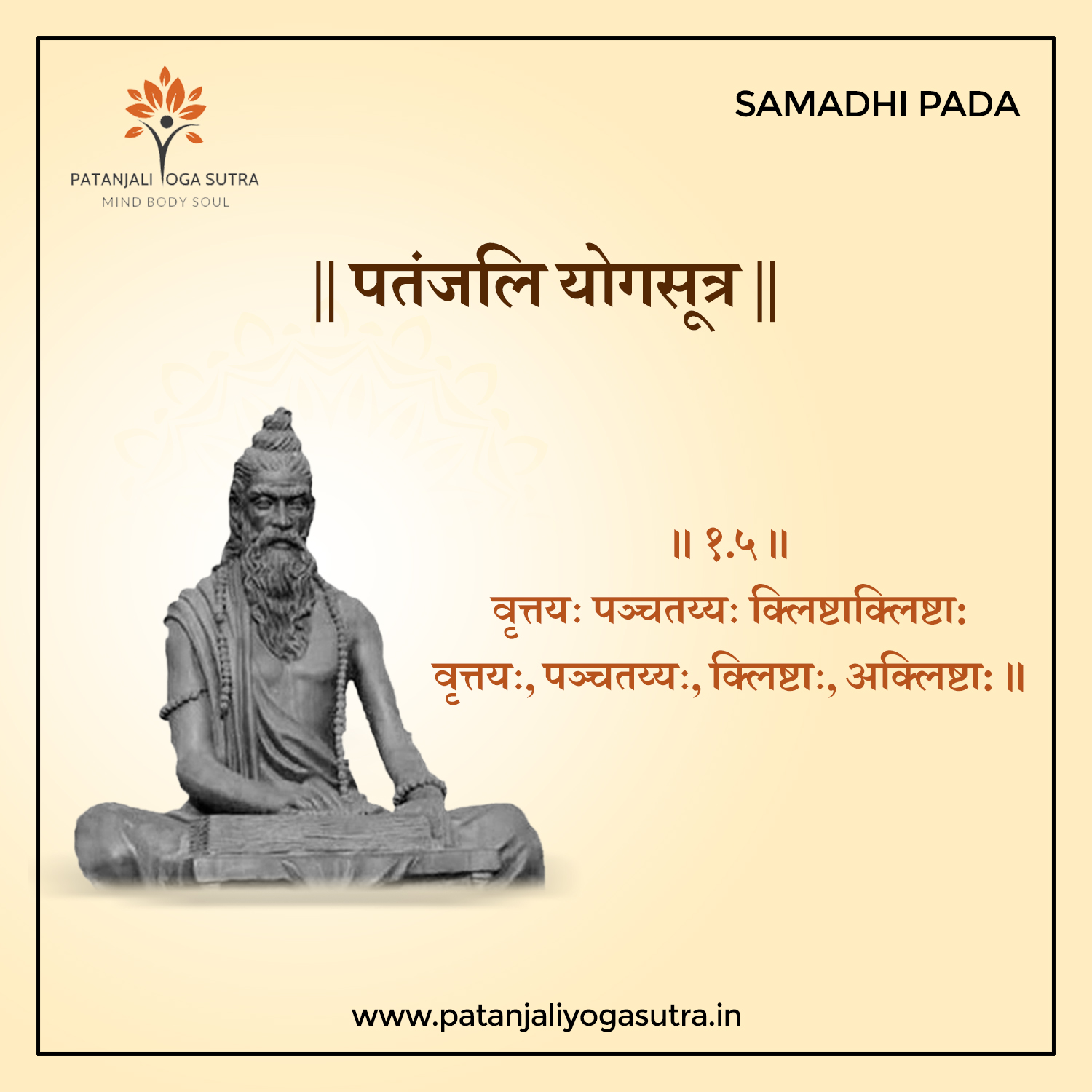



महर्षि पतंजलि ने समाधिपाद के दूसरे ही सूत्र में वृत्ति निरोध की बात की है, लेकिन ये वृत्तियाँ क्लिष्ट और अक्लिष्ट भेद से दो और संख्या अनुसार पांच प्रकार की हैं अर्थात प्रत्येक वृत्ति क्लिष्ट और अक्लिष्ट दो प्रकार से है।
सूत्र में क्लिष्ट और अक्लिष्ट ये दो शब्द आये हैं जिन्हें विधिवत समझना अत्यावश्यक है। योग दर्शन का पूरा विज्ञान वृत्ति निरोध पर आधारित है इसलिए वृत्तियों के विषय में सबसे अधिक स्पष्टता होनी चाहिए, क्योंकि जब तक हम समस्या को अच्छी प्रकार से नहीं समझेंगे तब तक उसका निदान या निराकरण कैसे कर पाएंगे।
इसलिए आईये समझते हैं कि क्लिष्ट वृत्तियाँ क्या होती हैं- व्यास भाष्य के अनुसार वे वृत्तियाँ जो अविद्यादि पांच क्लेशों (अविद्या, अस्मिता, राग, द्वेष और अभिनिवेश) को जन्म देने वाली होती हैं और जो कर्म जनित संस्कारों की उर्वरा भूमि होती हैं वे सभी वृत्तियाँ क्लिष्ट हैं। सीधे शब्दों में कहें तो जो दुःख देती हैं वे वृत्तियाँ क्लिष्ट हैं और निरोध करने योग्य हैं।
ऐसी वृत्तियाँ जो विवेक से उत्पन्न ज्ञान देने वाली तथा सत्व, रजस और तमस के प्रभाव को रोकने वाली होती हैं वे अक्लिष्टा वृत्तियाँ होती हैं अर्थात ऐसी वृत्तियाँ जो सुख प्रदान करने वाली होती हैं उन्हें अक्लिष्टा वृत्ति कहते हैं। अक्लिष्ट और क्लिष्ट वृत्तियाँ भी एक दूसरे में स्वतंत्र सत्ता लिए साथ साथ भी उत्पन्न हो जाती हैं। अक्लिष्ट एवं क्लिष्ट वृत्तियों से अक्लिष्ट और क्लिष्ट संस्कार भी चित्त में बनते एवं संग्रहित होते रहते हैं। वृत्ति और फिर उससे निर्मित एवं संग्रहित संस्कार मनुष्य को संसार में चलायमान रखते हैं जब तक कि वृत्ति निरोध से समाधि घटित नहीं हो जाती। साधक के गुणातीत होने पर ही आत्मा अपने विशुद्ध स्वरूप में प्रतिष्ठित होती है।
आगे जब सूत्र में पांच प्रकार की वृत्तियों को उनकी परिभाषा के साथ समझेंगे तो साथ ही यह भी समझने का प्रयास करेंगे कि कैसे एक ही वृत्ति दुख देने वाली है और सुख देने वाली भी। यदि साधक वृत्तियों के क्लिष्ट और अक्लिष्ट भेद को भली भांति समझ ले तो जीवन जीने का आनंद और जीवन मुक्ति का आनंद दोनों साथ साथ प्राप्त कर सकता है।
Maharshi Patanjali has mentioned vritti niruddh in second section of Samadhi pada. These vritties are of two types based on their nature Kalisht (unpleasant) and akalisht (pleasant) but according to Samkhya there are five types of vritties i.e each vritti is either unpleasant or pleasant.
It is very important to duly understand the words Kalisht and Akalisht in the section. The entire science of Yoga Darshan depends on vritti niruddh so there should be utmost clarity on vritties because unless we know the problem we cannot find a solution to it.
So let’s first understand kalisht vritties- As per the commentary of Vyas, vritties that give rise to five sorrows including spiritual ignorance (ignorance, ego, attraction, aversion and clinging to life) provide the fertile land to sanskaras born out of actions (karma). All these are kalisht vritties. Simply put the vritties that inflict pain and suffering are called Kalisht (negative) vritties and need to be stopped.
The ones that prevent the effect of satva (virtuousness), rajas (confused) and tamas (destructive, obscure) and provide discretionary knowledge are called akalisht (positive) vritties. These vritties give pleasure. Kalisht and Akalisht vritties can be generated simultaneously in each other with independent power. Along with them kalisht and Akalisht sanskaras are also built and stored in the mind. These vritties and the sanskara built and stored by them keep the man going in this world till Samadhi happens through vritti control. After the practitioner acquires virtues then the soul gets established in its pure form.
Later on we will study about five types of vritties along with their definitions and we will also try to understand how the same vritti can be hurtful as well as pleasurable. If the practitioner clearly understands the difference between kalisht and akalisht vritties then he can enjoy a blissful life as well as death.
सूत्र: वृत्तयः पञ्चतय्यः क्लिष्टाSक्लिष्टा:
अच्छे और बुरे प्रयोग से वृत्तियों पांच बतलाई हैं
क्लिष्ट शब्द से बुरा कहा और अकलिष्ट से शुभ समझाई हैं।
Perfect defination ” PUJAY SHREE” we r satisfied & don’t have any question after this defination , we r getting intrest also for furthers sutras.
ॐ स्वामी जी, बहुत ही सुन्दर व्याख्या किया गया है | आनंद आ गया | क्लिष्ट एवं अक्लिष्ट वृत्तियों के भेद को जानकर साधक दुखी अथवा सुखी होने का अनुभव करता है |
This is an extraordinary effort to translate the verses into different languages. Also, splitting the verses word by word is worth applauding. Salutes to you.
Thank you Dr Aditya bhat ji. Your kind review gives us strength to further simplify our structure. Thanks again
Bahut achche se varnan kiya gaya h
Thanks Very much… For your Kindness by Posting Patanjali Yog Sutra in Hindi.🙏🙏🙏